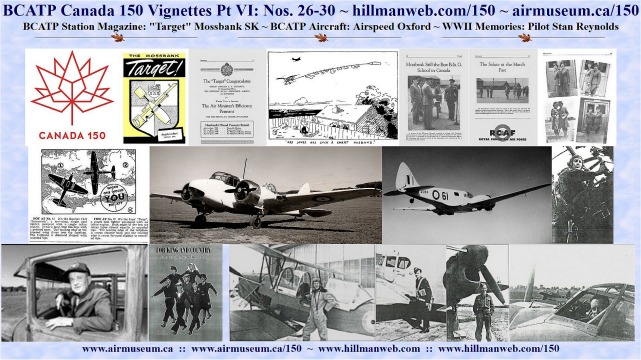028 of
150
BCATP A World War II Memory: Stan Reynolds - Pilot
- Part 1 of 3
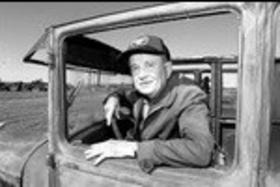 In
December 2000, the Commonwealth Air Training Plan Museum received this
air force history from Stan Reynolds. It is one chapter out of a book commissioned
by the Alberta Department of Culture commemorating the 50th anniversary
of the end of hostilities in World War II. The book is "For King and Country
– Albertans in the Second World War" and Stan’s chapter was in the Albertans
Overseas section.
In
December 2000, the Commonwealth Air Training Plan Museum received this
air force history from Stan Reynolds. It is one chapter out of a book commissioned
by the Alberta Department of Culture commemorating the 50th anniversary
of the end of hostilities in World War II. The book is "For King and Country
– Albertans in the Second World War" and Stan’s chapter was in the Albertans
Overseas section.
Stan entitled his chapter: "From Air Training
to the Defence of Britain: One Pilot's View From Tiger Moths to Mosquitoes."
It is a fascinating by story but much too long for
one Canada 150 Vignette so we have split it into three Vignettes with each
covering Training in the British Commonwealth Air Training Plan, Training
Overseas in an Operational Training Unit and Air Operations overseas.
Part 1 – Training in the British Commonwealth Air
Training Plan
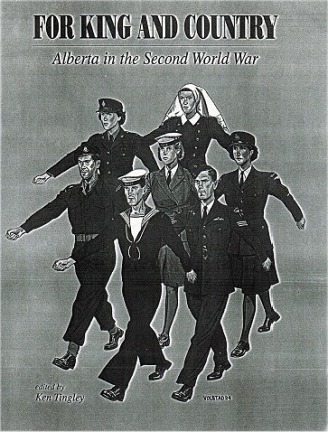 The
Reynolds family of Wetaskiwin has always been interested in aviation. My
father, Edward A [Ted] Reynolds, was a pilot in the Royal Flying Corps
during the First World War. My older brother, Byron E. [Bud] Reynolds,
joined the Royal Canadian Air Force in 1940, and completed a Tour of Operations
as a flight engineer on Catalina flying boats. My younger brother, Allan
B. [Bert] Reynolds, joined the RCAF in 1943, and served overseas as an
air-frame mechanic on Dakotas [C-47s] with 437 Squadron. When I was sixteen
years old I joined the Edmonton Fusiliers and trained with E Company at
Wetaskiwin during periods that did not conflict with school hours. The
two weeks' training at Sarcee Camp in Calgary during the summer months
was a great experience, with sleeping in tents and target practice with
Ross rifles. In 1941 I was hired as a truck driver for MacGregor Telephone
& Power Construction Co. of Edmonton during the time they were installing
power lines at the RCAF stations at High River, Claresholm, De Winton,
and other locations.
The
Reynolds family of Wetaskiwin has always been interested in aviation. My
father, Edward A [Ted] Reynolds, was a pilot in the Royal Flying Corps
during the First World War. My older brother, Byron E. [Bud] Reynolds,
joined the Royal Canadian Air Force in 1940, and completed a Tour of Operations
as a flight engineer on Catalina flying boats. My younger brother, Allan
B. [Bert] Reynolds, joined the RCAF in 1943, and served overseas as an
air-frame mechanic on Dakotas [C-47s] with 437 Squadron. When I was sixteen
years old I joined the Edmonton Fusiliers and trained with E Company at
Wetaskiwin during periods that did not conflict with school hours. The
two weeks' training at Sarcee Camp in Calgary during the summer months
was a great experience, with sleeping in tents and target practice with
Ross rifles. In 1941 I was hired as a truck driver for MacGregor Telephone
& Power Construction Co. of Edmonton during the time they were installing
power lines at the RCAF stations at High River, Claresholm, De Winton,
and other locations.
The crews slept in tents and my job was driving and looking
after MacGregor's 1928 Ford one-ton truck. At this time a local fellow
Dallas Schmidt, home on leave from the RCAF, stopped at my father's garage.
I was impressed to see him in his officer's uniform. That dapper uniform
and his enviable war record probably increased my desire to join up. Dallas
Schmidt received two Distinguished Flying Crosses and was promoted to the
rank of Flight Lieutenant while flying Beaufighters during the Defence
of Malta. I was in the process of finishing my grade 12 education when,
early in 1942, an RCAF recruiting group came to Wetaskiwin and set up a
desk in the Driard Hotel. Curiosity and my desire to learn how to fly prompted
me to visit the recruiting officer. I was told that I could enlist in the
"Pilots and Observers" category, and if I passed the required tests I would
be selected for training as a Pilot or Observer. The recruiting officer
was quite persuasive and before I left the hotel I had enlisted.
On 15 April 1942 I was called to Edmonton to start training
at RCAF No. 3 Manning Depot. I was assigned living quarters in a barracks
which housed about fifty airmen, and we slept in two-tier bunks. Except
for a few technicians we all started with the rank of AC2 [Aircraftsman
second class]. We were issued uniforms, mess kits, sewing kits called "housewives,"
brass button polishers, shoe shiners, and other gear. We received medical
and dental checkups. inoculations, physical training, marching drill, and
lessons in airmanship. Each airman made his own bed, polished his buttons,
badges and shoes and the entire group received periodic inspections. Everything
had to be kept neat and clean, strict discipline was enforced and every
man did his stint on guard duty.
When a group of about forty Australian airmen arrived
at the Manning Depot they decided to take in some Edmonton city night life,
even though they did not have permission to leave the base. They elected
to leave the base when I was on guard duty, and when I was near the farthest
end of my beat they made a hole in the fence big enough for a man to crawl
through. When I turned around at the end of my beat I saw a long lineup
of men in their dark blue Australian uniforms, in single file, crawling
hurriedly through the hole in the fence. I was carrying a .303 Enfield
rifle with fixed bayonet, but no ammunition was allowed for anyone on guard
duty. Being quite confident that I would not be able to stop these Australians,
I began running towards them, mostly running on the spot, waving my rifle
and shouting "Halt in the name of the King." They did not pay any attention
to me and when I arrived at the hole in the fence the last Australian was
a few feet too far away for me to reach him with the bayonet. Someone else
was on guard duty when the Australians returned [probably during the early
hours the next morning]. I heard no more about it so I presumed they got
back without incident.
During passes I would hop on my 1928 Harley Davidson motorcycle
and head for Wetaskiwin, where I spent most of the time building a Model
T Ford race car from parts at my father's auto wreckage. The category "Pilots
and Observers" was discontinued and all airmen in that category were remustered
to "Aircrew." This meant that any airman could be selected for training
as a pilot, navigator, bomb aimer, wireless air gunner or air gunner. On
19 July 1942, I was posted to No.7 Initial Training School at Saskatoon.
There were 42 airmen in Course #58 and we received classes and tests in
mathematics, wireless, navigation, meteorology, armament, anti-gas measures,
airmanship, drill, administration, and aircraft recognition. White cloth
flashes were placed in the front of our wedge caps to signify that we were
aircrew trainees. My Link trainer instructor was a Flying Officer Elder.
I passed the Link trainer portion of the course with the grade of 89 per
cent which, I was told, was the highest mark in the class. After the final
exams each graduate was interviewed individually by the selection committee
which, after considering the airman 's abilities, decided which members
of air crew should receive
training. I wanted to be a pilot and was pleased to be
selected for pilot training
All graduates of the course were promoted to LAC [Leading
Aircraftsman] and were given cloth propellers which were sewn on the sleeves
of their clothing to indicate their rank. Squadron Leader Fred McCall of
Calgary, the famous First World War ace, was one of the officials in the
picture when the class photograph was taken. Thirteen of the aircrew in
this class were killed on active service.
The graduates were authorized to have a pass the following
weekend in early October. The Model T Ford races were being held in Edmonton
on Thanksgiving day, 12 October. I had my car entered in the races, and
consequently I made an arrangement with the Station Warrant Officer by
which I would stay on the station the weekend of 3 October and would receive
my pass the following weekend. I was put to work in the station hospital
and spent the entire weekend doing undesirable jobs, mostly cleaning washrooms
and toilets. I did what I was told to do, I did a good job and I did not
complain about anything. When the following weekend arrived I was told
all passes were cancelled. Considering that it had taken nearly all of
my leave periods during the past five months to complete the assembly of
the race car, that it was painted with RCAF lettering and roundels on both
sides, that the Edmonton and other newspapers had published write-ups and
photographs promoting me and my car in the races, that I had been promised
leave to attend the races, and that I had already paid the consideration
by working the previous weekend in the hospital, I believed I was entitled
to leave to attend the races. When I left the station that weekend without
a pass I was considered to be AWL [away without leave].
I proudly raced my car and won second prize in the second
race. When I returned to Saskatoon, Squadon Leader Bawlf, the Chief
Ground Instructor, announced to other classes that I had gone AWL and was
therefore washed out of aircrew. I believe this announcement was to emphasize
to other students the consequences before they considered going AWL. As
I was now ground crew I was put to work in the camp kitchen where I washed
dishes, pots and pans, dished out meals in the mess hall, and scrubbed
tables and floors . Once again I did what I was told to do, I did a good
job and I did not complain about anything. After two weeks of kitchen duty
I was called into the office of Wing Commander Russell, the Commanding
Officer. He told me that I was being put back into aircrew and was being
sent to No. 6 Elementary Flying Training School at Prince Albert for pilot
training. It appeared he had received good reports of my work and discipline
while I was on kitchen duty; however, he never asked me why I had gone
AWL and I believe he never was fully aware of the reasons.
On 25 October I was posted to EFTS, where I was one of
45 students in Course #67. We were issued flying suits and other items
needed for our flying training and ground classes. My first flight in a
Tiger Moth biplane was on 28 October; my first solo flight was on 9 November,
after receiving eight hours and 45 minutes of dual-flying training. Most
of the flying instructors were civilians, and during flights they talked
to the students through speaking tubes called Gosports.
On 23 November I was given a 30-hour check by Ernie Boffa,
a well known bush pilot who was the Assistant Chief Flying Instructor.
During the test I was required to do various manoeuvres, including slow
rolls, blind flying [flying by instruments while under a hood], practice
forced landings, cross-wind landings, steep turns, tail spins, side
slipping, and other exercises. While practising aerobatics during a solo
flight on 28 November, an oil line ruptured and I flew back to base with
oil spraying on the windscreen. I flew 29 different Tiger Moths at EFTS;
my last flight there was on 18 December by which time I had logged 73 hours
and 25 minutes flying time on Tiger Moths. In my log book endorsement in
the space allocated for "Instructor's remarks on pupil's weakness" was
written "no particular faults." My flying grade was 74 per cent, and my
assessment was "above average." At least 14 pupils from Course 67 were
"washed out," which means their pilot training was terminated. Ten of the
students in this course were killed on active service overseas.
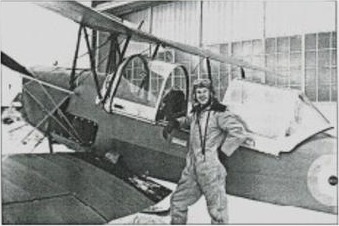
Pilot student Stan Reynolds
at No. 6 EFTS, Prince Albert, Saskatchewan, December1942.
The Tiger Moth is equipped with skis.
A Gosport hearing-tube needed for in-flight conversation
between instructor and student hangs from his helmet.
Photo courtesy Stanley G. Reynolds.
After completing my elementary training in December, I
went home on leave. A U.S. pilot flying a Bell Airacobra fighter experienced
engine trouble during a flight to Alaska, baled out and the plane crashed
nose first into the ground near Wetaskiwin. Personnel from the US air base
at Namao picked up all the parts they could locate, but they left the engine
which was buried about 17 feet down in the ground. I took it upon myself
to dig out the Allison V 12 engine, the 37 mm cannon that was buried under
the engine, live ammunition, propeller, and other gear. When I was digging
out the engine a spectator standing nearby threw a cigarette into the hole,
causing an explosion of the gas fumes. I came out of the hole so fast I
don't know whether I jumped out or was blown out. Not knowing of any useful
purpose for the articles, my father notified U.S. officials who sent an
army truck to pick up the remains of the Airacobra.
On 10 January 1943 I was posted to No.4 Service Flying
Training School at Saskatoon, where I was placed in Course #72 with 61
other student pilots. We were learning to fly twin-engine Cessna Cranes,
and my flying instructor was Pilot Officer Macintyre. My first solo in
a Crane was on 24 January, after receiving eight hours and 40 minutes dual-training.
During a solo flight on 7 April the fuel pump quit in the starboard engine.
I flew back to base on one engine and made a successful single engine landing.
My last flight in a Crane was 22 April, by which date I had logged 166
hours and 40 minutes twin-engine day-and-night flying time. By then I also
had logged 35 hours in the Link trainer, not including my Link time at
ITS. At least 14 pupils in Course 72 were washed out. Not every pilot received
his wings on the parade square. A day or two before this important occasion
I was stricken with appendicitis and taken to the base hospital where I
received an appendectomy.
As I was not allowed to leave the hospital bed, my pilot
wings were pinned on my pyjamas by an officiating officer from high command.
In attendance were my instructor, other graduating pilots from my course,
the doctor and nurse, various officials from the base and my very proud
father. This was one of the most thrilling experiences in my air force
career. I had graduated from SFTS flying twin-engine Cessna Cranes, and
was now a full-fledged pilot. In my log book endorsement in the space allocated
for "Instructors remarks on pupil's weakness" was written "High average
student, should do well in all future flying." I was promoted to the rank
of Sergeant. Fifteen of the students in this class were killed - on active
service overseas.
It would not be an exaggeration to say that Stan Reynolds
was a legend in the museum and aviation community in Canada. After his
Royal Canadian Air Force Service in World War II, Stan returned to his
home in Wetaskiwin Alberta and grew a very successful automobile and farm
machinery business. His words in the story indicate that he acquired the
'collector bug' early in his life. He amassed a huge collection of vintage
automobiles, motorcycles, bicycles, trucks, stationary engines, tractors,
agricultural implements, aircraft and industrial equipment of which 1500
items were donated as a start to the Reynolds-Alberta museum in Wetaskiwin
Alberta. Among other honours, he was inducted in the Aviation Hall of Fame
in 2009 and named to the Order of Canada in 1999.
Reynolds died in February of 2012 at the age of 88
years and his wife Hallie, passed away in August 2012 at the age of 85
years.
029 of
150
BCATP A World War II Memory: Stan Reynolds - Pilot
- Part 2 of 3
Part 2 – Training Overseas in a OTU (Operational
Training Unit)
I went home on embarkation leave prior to leaving for
overseas. I boarded a train with other airmen, and arrived at No.1 "Y"
Depot, Halifax, Nova Scotia, on 21 June. A few days later we boarded the
troop ship "Louis Pasteur," joined a convoy and headed for England. The
ships travelled in a zig-zag path to lessen the chances of being hit by
a torpedo from an enemy submarine. We were told that some submarines were
picked up in the ships sonar, although no ships were torpedoed in this
convoy.
On Dominion Day I was posted with other pilots to No.
3 Personnel Receiving Centre at Bournemouth, on the south coast of England.
This city had been the target of a low-level attack by enemy aircraft and
a number of buildings showed mute evidence of the strafing and bombing.
At Bournemouth we were given training in parachute-harness releasing over
land and water, use of the life preservers called "Mae Wests," jumping
into a pool of water from a high platform, and lots of physical exercise
which included routinely swimming several lengths of the swimming pool.
We also received instruction on the use of firearms, and did target practice
with revolvers. As part of our emergency kit, our photographs were taken
in civilian clothes, to be used by the underground for forged passports
if we were forced down in enemy territory.
We received training and tests on wireless, aircraft recognition,
link theory, armament, ship recognition, and naval theory. On 26 and 27
August, at the Empire Central Flying School at Hullavington, I took flight
tests in a Miles Master and an Airspeed Oxford. From Bournemouth the pilots
were posted to various bases for further flight training, depending upon
their qualifications and capabilities. I was fortunate to have good night
vision, good aircraft recognition and my ability as a pilot was satisfactory
so it was decided my further flying training should be as a night fighter
pilot.
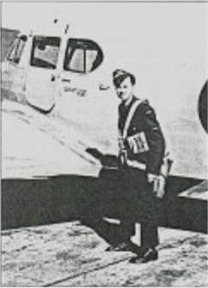
LAC Stan Reynolds readies himself for a solo flight
in a Cessna Crane at No. 4 SFTS, Saskatoon, during April 1943.
Note the quick release fastener at the front of
the parachute harness and the ripcord on his left side.
Photo courtesy Stanley G. Reynolds.
On 22 September I was posted to No. 12 Advanced Flying
Unit at Grantham, Lincolnshire, where I was one of 51 pilots in Course
#17. In this course were servicemen from around the world: 33 RAF, six
RCAF, four RAAF [Royal Australian Air Force], two RNZAF [Royal New Zealand
Air Force], two SAAF [South African Air Force], an airman from Pol and
one from Java, one from Scotland one from USA. One of the pilots in this
course was S/L George Edwards, who was the Chief Flying Instructor during
the time I was training at No. 4 SFTS Saskatoon. We were flying twin-engine
Bristol Blenheim Mark Vs, known in England as 'Bisleys.' I received 4 ½
hours dual-instruction before my first solo flight on 8 October, and was
promoted to Flight Sergeant on 30 October.
Shortly before Christmas a group of about half a dozen
airmen in my barrack block got together to play carols using a group of
bottles partially filled with water. Each bottle was filled to a different
level to produce a different musical note when an airman blew over the
top of the bottle. Each of us controlled several bottles and after hours
of practice we became quite proficient in playing "Good King Wenceslas."
During a solo cross-country flight on 24 February 1944,
the ceiling, 10/10th overcast, came down and I was forced down to under
300 feet to fly below the low ceiling. Endeavouring to map read at such
a low height while flying over territory containing numerous roads and
railways crisscrossing and running all directions, often having to read
the aircraft instruments and look ahead for obstructions, I became lost.
I flew with 15 degrees of flap to maintain safe control at a slower speed,
but I was unable to pinpoint my location on the map. I still had a reasonable
fuel supply when I flew over an air base where the planes were all grounded
because of the bad weather. I made a quick circuit, landed and taxied up
to the control tower. The control officer said that if I shut off the engines
I would have to stay. Therefore I left the engines idling at 1000 rpm,
set the brakes, and walked into the control tower where I was told I had
landed at Polebrook, a United States Air Force base. I drew a line on my
map from Polebrook to Grantham, took off and map-read my way back to my
base, landed and parked the plane in its proper place. When I landed at
Grantham I was over two hours late; however nobody asked me why I was overdue.
Flying Officer Osborne, RAF, was one of the pilots killed during the flying
training of Course #17.
Ground school classes were Morse code wireless, navigation,
meteorology, aircraft recognition, armament, and engines. During a pass
I went to London and spent the night at a servicemen's hostel at Earls
Court. That night the air raid sirens began wailing and the German planes
dropped their bombs. Instead of going to an air raid shelter as most cautious
people would do, I stayed in my room which was on an upper floor. I could
not quite muster the urge to leave the hostel bed and traverse four flights
of stairs for a sojourn in a bomb shelter. Next morning I looked out the
window and noticed that the street was barricaded. A large bomb had dropped
in the street in front of the building but had failed to explode. Being
a born collector I picked up from the streets of London about twenty pieces
of shrapnel which I still have.
On 29 February I was posted to No. 51 Operational Training
Unit at Cranfield, Buckinghamshire. Here we had to learn to fly twin-engine
Bristol Beaufighters, an airplane which had a gross weight of over twelve
tons, and a top speed of over 300 mph. This was a plane on which we could
not receive dual instruction because it had only one front seat and no
provision for a second pilot. I was in Course #31 which had 25 pilots and
24 radio navigators. Six of the pilots held the rank of Flight Lieutenant
or higher. One of the pilots was a Technical Sergeant in the United States
Army Air Corps. An RAF Sergeant, who was not a member of aircrew, gave
each pilot instruction while he was sitting in the pilot's seat of a Beaufighter
cockpit section called a "dummy fuselage." We had to learn the readings
and all the operations of the instruments, gauges, switches, controls,
and radio. We had to be proficient in going through the sequences of operations
needed by a pilot during takeoff, climb, flight, gliding, and landing.
This would include adjustment of the propellers, engine coolers, retracting
the landing gear, operation of the flaps, and radio operation.
When the ground instructor was satisfied that the pilot
knew what to do in the cockpit, he would approve the pilot to fly the Beaufighter.
I received nine hours and 40 minutes dual day-and-night flying, and instrument
flying in a Bristol Beaufort. On 19 March I made my first solo flight in
a Beaufighter. After 5 ½ hours of solo flying I was assigned a radio-navigator,
Sergeant Donald MacNicol from Winnipeg. The call sign allocated to me was
"Jungle three niner," used mostly during radio communications. During time
off we often chummed around with another crew in the same course, Sergeant
Robert S. Walker, a pilot, and Sergeant George R. Fawcett, his radio-navigator.
During a landing on 23 April the port tire blew out and the drag was too
great to keep the Beaufighter on the runway. The wheel tore a deep groove
in the sod, although the plane was undamaged. There was another pilot coming
in to land behind me, and after I got stopped I heard his voice on the
radio saying "good show three niner!"
During a night flight in April I was flying near London
when several flights of German aircraft began dropping bombs. I could see
the German planes coned in the searchlights with numerous anti-aircraft
shells exploding around them. There was nothing I could do because on training
flights we carried no ammunition for the guns. During night flights we
were directed by ground control which gave us messages by radio. The Germans
had jammed our radio frequencies during the raid so I could not be vectored
back to base. Also the lights were shut off at the airfields to prevent
them from becoming a target, so I was unable to land during the raid. After
the raid was over and the radio jamming was lifted I was directed back
to my base. On 30 April, after 32 hours and 55 minutes day-and-night flying
training in a Mark I Beaufighter plus numerous hours in ground classes
I finished my course at No. 51 OTU.
030 of
150
BCATP A World War II Memory: Stan Reynolds - Pilot
- Part 3 of 3
Part 3 - Aircraft Operations Overseas
On 1 May Don MacNicol and I were posted to RAF Station
Winfield on the east coast of Scotland. We were the only RCAF crew in "A"
Flight. All the rest of the fifteen crews were RAF. Robert Walker and George
Fawcett also were posted to Winfield and were one of sixteen crews in "B"
Flight. From this base most of our flights were over the North Sea in Mark
VI Beaufighters, with two Bristol Hercules 1650 horsepower engines, four
20 mm cannons, six .303 machine guns and radar in the nose. We flew Mark
II Beaufighters with Rolls
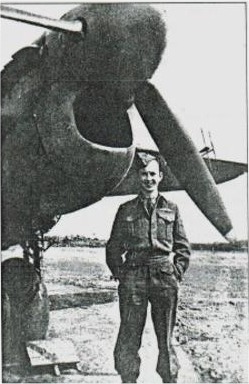
F/S Stan Reynolds wearing "battle dress"
beside his Mark II Beaufighter
at RAF Station Winfield, Scotland in May 1944.
A radar antenna is fastened to the port wing behind him.
Photo courtesy Stanley G. Reynolds.
Royce Merlin engines during air-to-ground firing, and
when firing at target drogues being pulled by Fairey Battles. One of the
first things we noticed was the number of WAAF [Women's Auxiliary Air Force]
working on airplane engines. With my folding camera, which I could carry
in my pocket, I took some photographs of these women at work. On 6 June
1944 [D-Day ], the supercharger in the starboard engine was unserviceable
so we flew back to base after a short flight. We were not informed about
the invasion until the next day.
On 11 June we flew back to base after a short flight for
the reason "weapons bent," meaning our guns wouldn't fire. Quite often
the night flying aircrew received carrots with their meals as the vitamins
in carrots were said to be of benefit to our night vision. Everyone had
brussels sprouts with most meals, and periodically a chicken egg was al
located to each flyer. We had to stand in a single-file queue, and when
we got to the front of the line we signed our name on a dotted line to
receive our single egg. Each airman took his own egg to the mess kitchen
and told the cook how he wanted it cooked; we would then eat the egg with
the rest of the meal that was dished out to us. Don MacNicol received comfort
parcels from home which contained cans of Spork, Spam, jam, peanut butter,
and margarine. He would take a can of jam or peanut butter to the mess
hall and put it on the table in front of us. After a few minutes RAF ground
crew would come over to our table with a slice of bread in their hand and
meekly ask if they could have a little bit of the jam or peanut butter.
Don never refused anyone, and soon the can was empty.
My twenty-first birthday was on 17 May, and on this day
I spent an hour and ten minutes flying a Mark II Beaufighter, firing 20
mm cannons at a target drogue being pulled by a Fairey Battle. Don became
quite friendly with Robert Walker, and asked if I would mind if he crewed
up with Walker, in which event George Fawcett would become my R/N [radio
navigator]. George and I had no objection, so MacNicol became Walker's
R/N and Fawcett became my R/N.
Late at night on 19 June George and I were "scrambled"
[took off] and vectored to intercept two "bogies" [enemyaircraft] flying
high over the North Sea towards Edinburgh. We had climbed to 16,000 feet
when the bogies had completed their reconnaissance mission and were heading
back towards Norway. During their flight they descended, at the same time
giving them a greater speed. Because we were on an interception course
we were able to get fairly close to one of the bogies, but not close enough
to be able to see the plane visually, which would enable us to fire our
guns. When our height was down to about 100 feet above the North Sea waves,
we had to level out and the German planes, being faster than our Beaufighter,
pulled away from us. Later we were told that they were probably Messerschmitt
21 Os based in Norway. On 21 June, after 31 day-and-night flights in Beaufighters,
I was posted with my R/N to 410 Cougar Squadron RCAF based at Zeals, Wiltshire.
At this time 410 Squadron was assigned to the Defence
of Britain. It was a night fighter squadron equipped with Mark XIII and
Mark XXX DeHavilland Mosquitoes fitted with four Hispano Suiza 20 mm cannons
in the belly and radar equipment in the nose. They had two Rolls Royce
Merlin 1650 horsepower engines, and a top speed of 420 miles per hour.
There were instruments, gauges and controls on both sides as well as in
the front of the cockpit, and the radio had 32 channels. There also was
one Mark III Mosquito that had dual controls. On 23 June, with F/0 Edwards
at the controls and me in the other seat, he flew one circuit, then told
me to fly a circuit. After I landed he told me to continue flying circuits
and left me alone in the plane. I took off on my first solo flight in a
Mosquito, and practised takeoffs and landings for an hour and 25 minutes.
I thought to myself at the time how much nicer and easier it was to fly
the Mosquito than the Beaufighter.
We were using a grass airfield without runways, smaller
than most other bases. We slept in tents on folding cots at that time.
When we took a shower we used a hand-pumper fire extinguisher filled with
water, and took turns spraying water on each other. W/C Abner Hiltz was
our Commanding Officer, and George Fawcett and I were one of sixteen crews
in "B" Flight. S/L J.D. "Red" Somerville was our Flight Commander, and
F/L Walter Dinsdale was the Assistant Flight Commander.
During a night flight in a Mark XIII Mosquito on 9 July,
the starboard engine burst into flame. I shut off the fuel line and switches
for this engine, feathered the propeller and activated the fire extinguisher
which put out the fire. I flew back to base on one engine, aniving about
2:30AM. When a twin-engine airplane flying on one engine slows below a
certain air speed, there is not enough rudder control to keep the aircraft
in a safe attitude if too much power is used on the operating engine. The
increased pull from the operating engine causes the plane to become uncontrollable
and crash. Consequently pilots are trained to approach the landing field
at a greater height than is usual; if there is an overshoot or undershoot
during landing, it is safer to hit the far fence at a slower speed than
it is to hit the near fence at flying speed.
When I was certain I would reach the landing field, I
activated the flap and undercarriage controls. There is a hydraulic pump
on each engine; as one engine was inoperative the hydraulic pump connected
to that engine was not working. The hydraulic pressure from the single
pump operated the flaps and undercarriage so slowly that they were only
partially down, and I could not get the plane stopped before I ran out
of landing space. As soon as I was aware that the plane was not slowing
down fast enough and the undercarriage was only part way down, I returned
the landing gear control to the retract position and the plane skidded
on its belly into a coulee adjacent to the landing field.
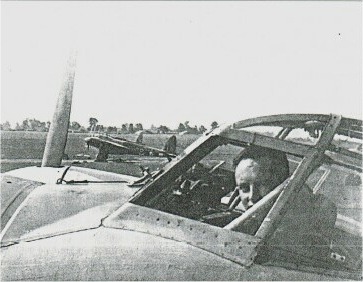
RCAF 410 Squadron Mosquito night Fighters
stationed at Colerne, Wiltshire, in August 1944.
Black and white striping was painted on the underside
of the aircraft shortly before D-Day.
Facial scars on pilot Stan Reynolds resulted from crash landing
his partially disabled Mosquito during a night flight in July 1944.
Photo courtesy Stanley G. Reynolds.
The plane could not be stopped while it was skidding down
the slope on the near side of the coulee; however, it came to a sudden
stop when it went across a small creek and hit the bottom of the ascending
slope on the other side. My head hit the instrument panel and I received
facial lacerations while George's jaw was broken. The port engine caught
fire, and in order to save time I disconnected my parachute and threw off
my helmet with earphones and oxygen mask, rather than disconnect them.
When I attempted to leave the plane I found my left foot was caught under
the damaged rudder bar. After twisting around and spraining my ankle in
the process, my foot became dislodged. By this time the fire was burning
up the left side of the fuselage singeing the left side of my clothing
and the hair on the left side of my head.
We crawled out a hole on the right side of the fuselage,
and while we were crawling away on our hands and knees the port fuel tanks
exploded. A few seconds later the ammunition also started exploding. After
we had crawled about 100 yards away we sat on the ground getting our bearings
and watching the burning plane. After another ten minutes we got up on
our feet, I put one arm over George's shoulders to take some of the weight
off my sprained ankle, and we walked about a quarter mile to a house. George
knocked on the door and an elderly lady in her night gown opened the door.
She was quite startled when she saw us with blood running down our faces
and the front of our uniforms. She let us in the house and after we told
her what happened she telephoned the base and a short time later we were
picked up by an ambulance-hearse, and taken to the base hospital.
Lacking any anaesthetic, the doctor stitched the lacerations
in my face without benefit of painkillers. Later we were strapped on stretchers
in an Oxford ambulance plane piloted by F/0 Snowden. With F!L Rogers, the
Medical Officer, in attendance, we were taken to Gatwick airport. From
Gatwick we were taken to the Queen Victoria Hospital at East Grinstead,
Sussex. Soon after we were placed in hospital beds and official photographs
were taken of our head wounds for the hospital records. I was visited by
Wing Commander Ross Tilley, the doctor in charge of the Canadian wing of
the hospital. He took a quick look at me, ripped the scabs off my face,
talked to me for a few minutes, then left to attend other airmen whose
injuries were more severe than mine. Many of the patients were burn victims
and were receiving plastic surgery from Dr. Tilley. Because this type of
surgery was in its infancy, and was somewhat experimental, these patients
became known as Guinea Pigs. A Club was formed and all patients who were
in the Queen Victoria Hospital became official members of the Guinea Pig
Club.
German V1 flying bombs, called "buzz bombs" or "doodlebugs,"
flew over quite often on their way from France to London. During my recovery
at the Queen Victoria hospital the patients were visited by an entertainment
group from the Women's Division of the RCAF, called the "All Clear" .group.
The lady in charge was Flight Officer Alice Fahrenholtz, who later married
Brigadier General William F. Newson, a member of Canada's Aviation Hall
of Fame. Some of the airmen who were not confined to their beds were honoured
by having their photograph taken with the young ladies. I was one of six
airmen who had their picture taken with four smiling ladies in their RCAF
uniforms; the pretty redhead wi th her hand resting on my left shoulder
was LAW [Leading Airwoman] Maureen Harrington from Edmonton. When I left
the hospital to return to the squadron I was picked up by F/0 Sexsmith
in an Airspeed Oxford. He was accompanied by W/0 Jones and W/0 Gregory,
who slept in the same tent as George and I. George was not released from
the hospital until later because his jaw had not yet healed.
On 5 August I was given a fli ght test in an Oxford by
F/0 Green, to check that the accident had not affected my flying ability.
On 8 August, being anxious to get back into the air, I took the Squadron
utility airplane, a Miles Magister, for an hour's flight. Many of the ground
crew wanted to get into the air whenever they had a chance,so I took LAC
Coffin. from Edmonton, as my passenger on this flight. On 11 August I was
back fl ying a Mark XIII Mosquito, and made three flights that day. In
August the squadron was moved from Zeals to Colerne, Wiltshire, an airfield
with paved runways. We were given RCAF Form R60, which was a Will, and
were urged to complete it. On 16 August 1 completed my Will, and another
air crew signed as witnesses. These were F/L Ben E. Plumer, pilot, from
Bassano, Alberta and his N/R F/0 Evans.
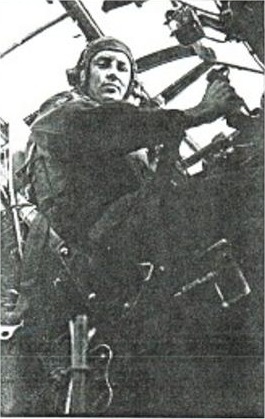
F/S Stan Reynolds in the cockpit of
a Mosquito Mark XXX Night Fighter in August 1944.
Photo courtesy Stanley G. Reynolds.
I flew a number of practice intercepts in which my Mossie
was the target and a crew in another Mossie would track me with their radar
and endeavour to catch or intercept me. During these exercises, both aircraft
carried loaded guns in the event either one or both planes were diverted
to intercept a bandit or buzz bomb. After 35 day-and-night flights in Mosquitoes,
I flew a Magister to an airport near London. From there I was sent to the
Repatriation Depot at Manchester, and received a promotion to Warrant Officer
second class effective 30 April. On 10 October my first RIN Don MacNicol
was killed while he was serving with 406 Mosquito night-fighter squadron.
On 14 October I was awarded a Wound Stripe for injuries received on active
service, and on 30 October was promoted to WO 1 [Warrant Officer first
class]. I left Manchester on the ocean liner Queen Elizabeth, which was
filled with troops, and several days later docked in New York harbour.
From there I travelled to eastern Canada, and then back to Alberta by train.
I was very disappointed when I was discharged in 1945,
as I liked to fly and would have been happy to stay in the air force as
a pilot. In January 1947 I received a letter from No.2 Air Command, RCAF
Winnipeg, stating that a Mosquito Squadron was to be formed for overseas
service, and offering ·me a five-year commission with the rank of
Flight Lieutenant. Later it was learned that this squadron was sent to
China where the Canadians taught Nationalist Chinese to fly and maintain
Mosquitos obtained in Canada for use against the Communists. By this date
I had built a garage, owned a car sales lot and had a business that was
progressing successfully. I therefore did not go back into the air force;
however, if I had done so it is probable that my future would have been
significantly different.
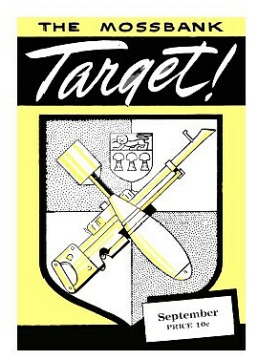
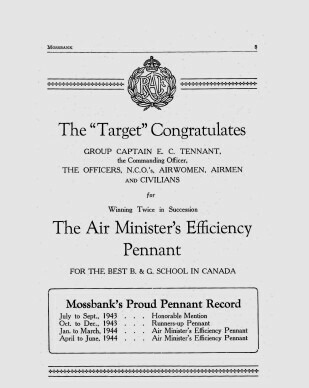
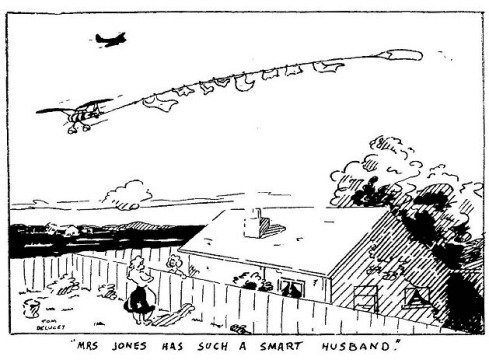
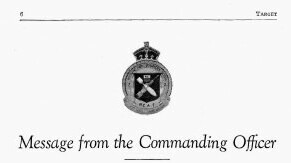 Always
it is the right spirit that counts: "Esprit do Corps", it is called in
the Service. It is no secret that the Spirit of Mossbank is the right spirit
andúthat which has made it possible for you to retain first place
in the awarding of the Minister for Air's Efficiency Pennant. You, each
one of you -Officer, N.C.O., airmam, airwoman and civilian alike -
Always
it is the right spirit that counts: "Esprit do Corps", it is called in
the Service. It is no secret that the Spirit of Mossbank is the right spirit
andúthat which has made it possible for you to retain first place
in the awarding of the Minister for Air's Efficiency Pennant. You, each
one of you -Officer, N.C.O., airmam, airwoman and civilian alike -
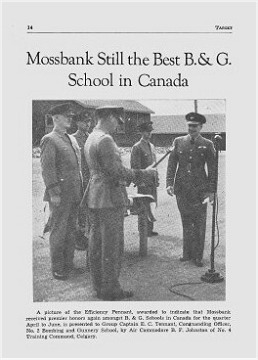
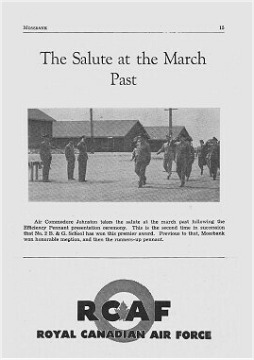
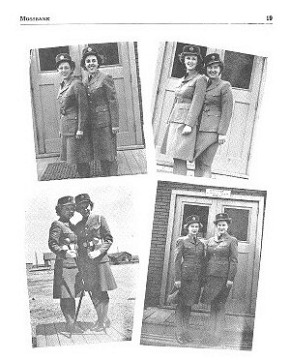
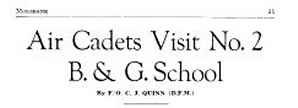 This
year No. 2 B.&G. School once more became the host of Cadets from the
surrounding district, and Calgary. There were two camps held, the first
from July 4th to July 14th. It was comprised of squadrons from Assiniboia,
Tugaske, Wilcox and Gravelbourg. The second camp was from July 18th to
July 28th, and was made up of only one squadron from Calgary.
This
year No. 2 B.&G. School once more became the host of Cadets from the
surrounding district, and Calgary. There were two camps held, the first
from July 4th to July 14th. It was comprised of squadrons from Assiniboia,
Tugaske, Wilcox and Gravelbourg. The second camp was from July 18th to
July 28th, and was made up of only one squadron from Calgary.
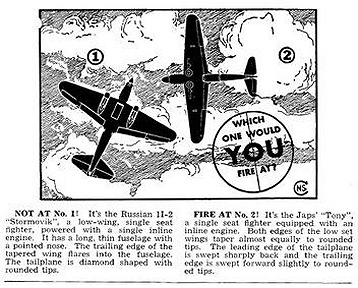
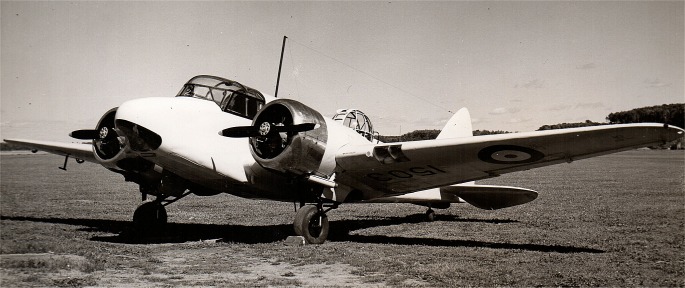
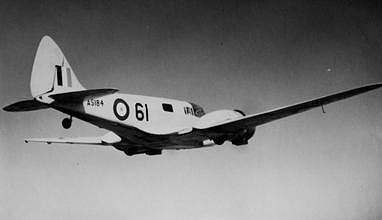
 In
December 2000, the Commonwealth Air Training Plan Museum received this
air force history from Stan Reynolds. It is one chapter out of a book commissioned
by the Alberta Department of Culture commemorating the 50th anniversary
of the end of hostilities in World War II. The book is "For King and Country
– Albertans in the Second World War" and Stan’s chapter was in the Albertans
Overseas section.
In
December 2000, the Commonwealth Air Training Plan Museum received this
air force history from Stan Reynolds. It is one chapter out of a book commissioned
by the Alberta Department of Culture commemorating the 50th anniversary
of the end of hostilities in World War II. The book is "For King and Country
– Albertans in the Second World War" and Stan’s chapter was in the Albertans
Overseas section.
 The
Reynolds family of Wetaskiwin has always been interested in aviation. My
father, Edward A [Ted] Reynolds, was a pilot in the Royal Flying Corps
during the First World War. My older brother, Byron E. [Bud] Reynolds,
joined the Royal Canadian Air Force in 1940, and completed a Tour of Operations
as a flight engineer on Catalina flying boats. My younger brother, Allan
B. [Bert] Reynolds, joined the RCAF in 1943, and served overseas as an
air-frame mechanic on Dakotas [C-47s] with 437 Squadron. When I was sixteen
years old I joined the Edmonton Fusiliers and trained with E Company at
Wetaskiwin during periods that did not conflict with school hours. The
two weeks' training at Sarcee Camp in Calgary during the summer months
was a great experience, with sleeping in tents and target practice with
Ross rifles. In 1941 I was hired as a truck driver for MacGregor Telephone
& Power Construction Co. of Edmonton during the time they were installing
power lines at the RCAF stations at High River, Claresholm, De Winton,
and other locations.
The
Reynolds family of Wetaskiwin has always been interested in aviation. My
father, Edward A [Ted] Reynolds, was a pilot in the Royal Flying Corps
during the First World War. My older brother, Byron E. [Bud] Reynolds,
joined the Royal Canadian Air Force in 1940, and completed a Tour of Operations
as a flight engineer on Catalina flying boats. My younger brother, Allan
B. [Bert] Reynolds, joined the RCAF in 1943, and served overseas as an
air-frame mechanic on Dakotas [C-47s] with 437 Squadron. When I was sixteen
years old I joined the Edmonton Fusiliers and trained with E Company at
Wetaskiwin during periods that did not conflict with school hours. The
two weeks' training at Sarcee Camp in Calgary during the summer months
was a great experience, with sleeping in tents and target practice with
Ross rifles. In 1941 I was hired as a truck driver for MacGregor Telephone
& Power Construction Co. of Edmonton during the time they were installing
power lines at the RCAF stations at High River, Claresholm, De Winton,
and other locations.





